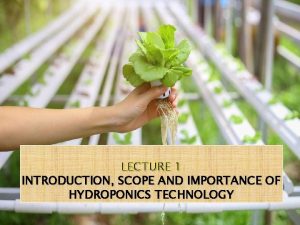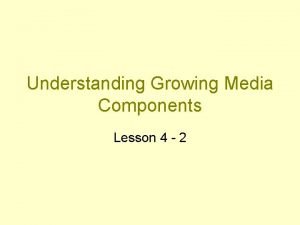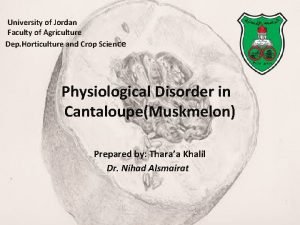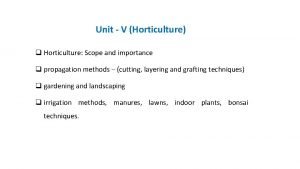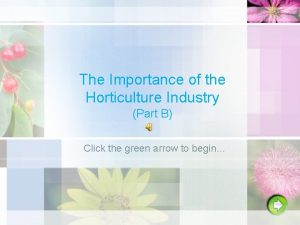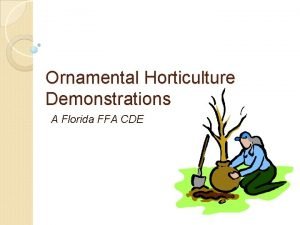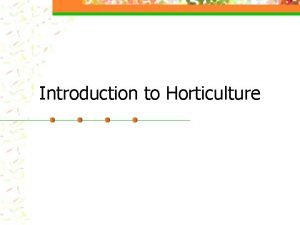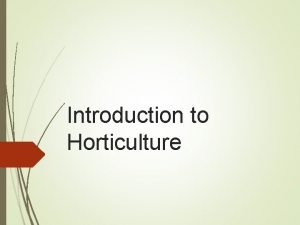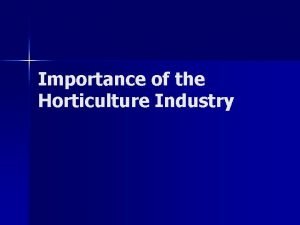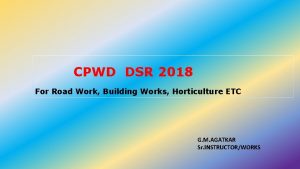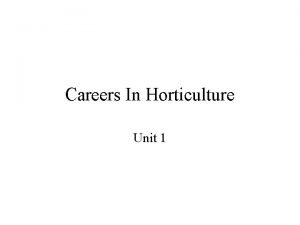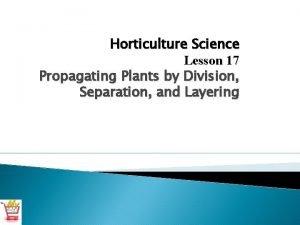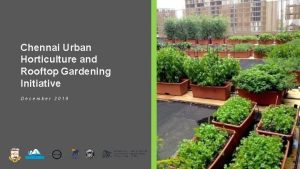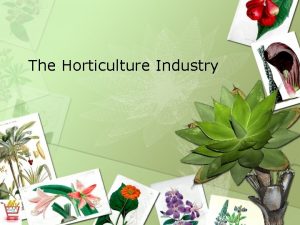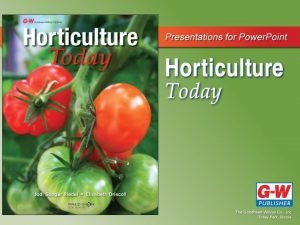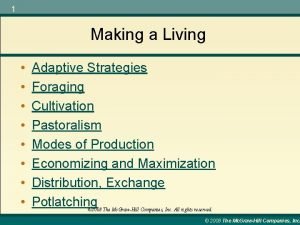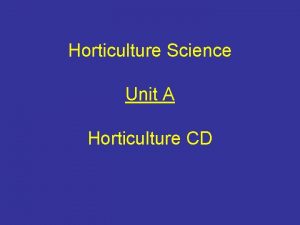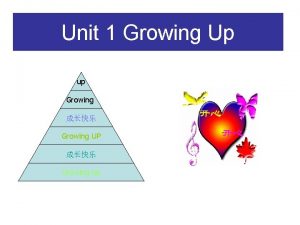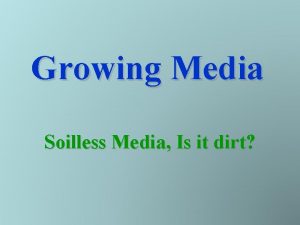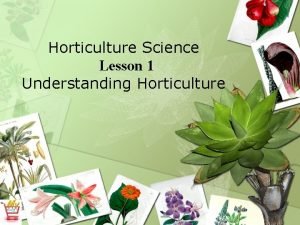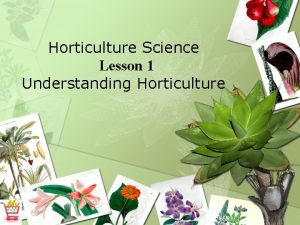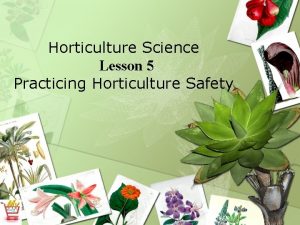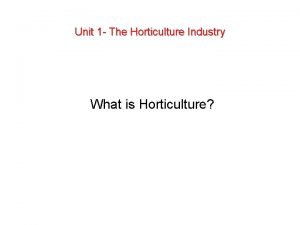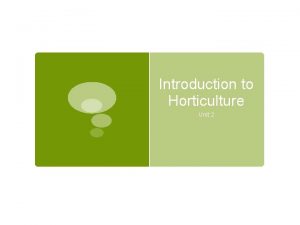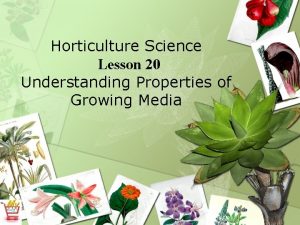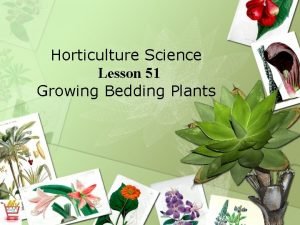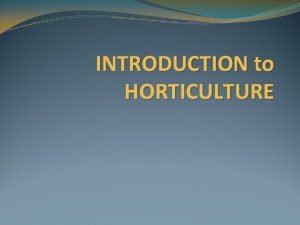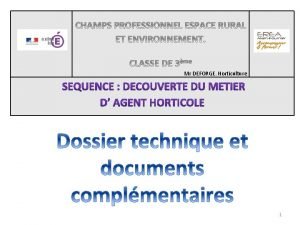Horticulture Science Unit A Horticulture CD Growing Media




























- Slides: 28

Horticulture Science Unit A Horticulture CD

Growing Media, Nutrients, & Fertilizers Problem Area 4

Understanding Growing Media Components Lesson 2

Interest Approach Judge a Soil by It’s Label! • Never look gift soil in the label! • What is in a soil? • Don’t count your plants before they germinate!

Interest Approach cont. What Is in a Soil? • DIRT? • No, dirt is what you track into the house!! • What makes soil drain well? • What makes soil hold nutrients? • What lets soil hold water or air?

Students Objectives After this lesson the student will be able to: 1. Describe the components of soil. 2. List the components of a soilless mix. 3. Compare and contrast the use of soil versus a soilless mix.

Terms • • Clay Inorganic Loam Mineral matter Organic matter Pasteurization Peat Moss Perlite • • Sand Silt Soil Amendment Soilless Mix Sterilization Vermiculite

What is Soil? • Soil – outer layer of the earth that supports life. • Recipe for Soil – 1 cu. Air – 1 cu. Water – 1 4/5 cu. Mineral matter – 1 tbl. organic matter – Mix thoroughly and let stand.

Soil is: • 25% air • 25% water • 45% mineral matter • 5% organic matter


Mineral Matter • Non-living substances generally thought of as weather rock. • Soil particles have 3 general sizes • Sand – largest and increases drainage (feels gritty) • Silt – medium size and gives a talc feel • Clay – smallest and higher water holding capacity, feels slick.

Organic Matter • Organic matter is living or dead plants and animals. • Organic matter is necessary for plant growth because of its high nutrient content. • Higher O. M. generally increases productivity.

What’s in a soilless mix? • A soilless mix is a combination of organic and inorganic substances that provide sufficient support for plant growth. • A soilless mix does not contain topsoil.

Home hydroponics in soilless medium

Common components in a soilless mix are: • Peat moss is plant material that originates in bogs. Peat moss has great moisture and nutrient holding capacity. • Perlite is white in color and comes from heat-treated lava rock. Perlite is used in the soil mix to aerate the soil.

Components Continued: • Vermiculite comes from the mineral mica and is shiny brown in color. It has high moisture holding capacity and is very lightweight. • Choir is fibers from coconut hulls which is hollow and aids in water and air holding while remaining lightweight.


Components Continued: • Sand large soil particles used to reduce overall water holding capacity • Amendments are add to change the air / water relationship of a mix while reducing the cost • Wetting Agents are soaps used to aid water uptake of the dry mix. Also aids in rewetting.

The advantages of a soilless mix are: 1. The mix is uniform. It does not vary in components, texture, or nutrients. 2. The mix is sterile. Sterilization is a process that eliminates all disease organisms, insects, or weed seeds. Soil mixes often contain these items and a grower who chooses to use a soil mix must pasteurize his or her soil before using it. Pasteurization is the process of heating soil to kill harmful diseases, weed seeds, and insects.

The advantages of a soilless mix are: 3. Soilless mixes can be manipulated to improve the drainage and moisture holding capacity of the mix. 4. A grower can personally mix the combination of components exactly to what he or she needs for their particular crop. 5. Soilless mixes are easier to ship and move because they are lightweight.

The disadvantages of a soilless mix are: 1. Fertilizers often need to be added more frequently to the mix because the mixes are lacking in minor plant food elements. Soil contains and holds many of these minor nutrients. 2. When plants are grown outdoors, the wind can blow dry pots over because the mix is very light.

The Disadvantages of a soilless Mix Are: 3. It is sometimes difficult to transplant a plant from a soil mix to a soilless one. The roots often will not grow into the new media and the plant will die because it can not absorb any moisture. 4. There is a cost to the media

REVIEW!

What are the ingredients of soil? • Air • Water • O. M. • Mineral Matter

What are the sizes of soil particles? • Sand • Silt • Clay

What are the materials used for soilless mixes? • • Peat Perlite Vermiculite Choir Amendments – bark, rice hulls, … Sand Wetting Agents

What are the advantages of mixes? • • Uniform Sterile Light Amendable

What are the disadvantages of mixes? • • Light Need nutrients Cost Transplanting issues
 International society for horticultural science
International society for horticultural science International society of horticulture
International society of horticulture Hydroponics is the science of growing terrestrial plants in
Hydroponics is the science of growing terrestrial plants in Types of growing media
Types of growing media Which soilless media component is brown and shiny
Which soilless media component is brown and shiny My favorite subject is english
My favorite subject is english Unit 1 growing up
Unit 1 growing up Unit 2 resources a growing nation
Unit 2 resources a growing nation Unit 10, unit 10 review tests, unit 10 general test
Unit 10, unit 10 review tests, unit 10 general test Dep horticulture
Dep horticulture Scope of horticulture
Scope of horticulture Olericulture jobs
Olericulture jobs 2018 dsr
2018 dsr Horticulture demonstration ideas
Horticulture demonstration ideas List of careers in horticulture
List of careers in horticulture Horticulture buyer jobs
Horticulture buyer jobs Branches of horticulture
Branches of horticulture History of horticulture
History of horticulture Importance of pomology
Importance of pomology Horticulture climate control
Horticulture climate control Dsr road work
Dsr road work Importance of horticulture
Importance of horticulture What plant is it
What plant is it Where did horticulture begin
Where did horticulture begin Tamil nadu horticulture terrace garden kit
Tamil nadu horticulture terrace garden kit Horticulture
Horticulture Definition of medicinal plants
Definition of medicinal plants Chapter 4 the horticulture industry
Chapter 4 the horticulture industry Yehudi cohen's adaptive strategies
Yehudi cohen's adaptive strategies


